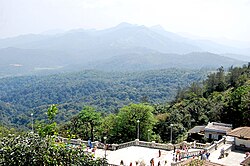Kodagu also known as Kodava Nadu, is an administrative district in Karnataka, India. It occupies an area of 4,102 square kilometres (1,584 sq mi) in the Western Ghats of southwestern Karnataka. In 2001 its population was 548,561, 13.74% of which resided in the district's urban centres, making it the least populous of the 30 districts in Karnataka. The district is bordered by Dakshina Kannada district to the northwest, Hassan district to the north, Mysore district to the east, Kannur district of Kerala to the southwest, and the Wayanad district of Kerala to the south. Agriculture is the most important factor that upholds the economy of Kodagu and the main crops cultivated in this region are rice and coffee. Coorg is rich in natural resources which included timber and spices. Madikeri (English: Mercara) is the headquarters of Kodagu.
Kodava Nadu is a tourist attraction, known for its coffee and its ethnic warrior people. The dominant group are its indigenous (Kodavas) and other ethnic groups (Arabasha and Kodava subgroups). Kodavas (freehold farmers, rulers and miltiamen), and offlate arabasha (farmers) from Sullia region also, who were freeholder farmers in sulia (a part of Kodagu in the 17th and 18th centuries) moved towards Kodagu after the massacare of kodavas (Through Treachery by Tippu and Hyder ali)in Somavaerpet, Bagamandala, Kushalnaga and parts of Piryapatna (Presentday mysore region founded and ruled by a kodava paryaraja,Parya meaning elder in kodava)for agricultural activities in kodagu due to wars with Tippu and Hyderali before there death in recent past. The chief languages presently spoken in Kodagu are Kodava, Are Bhashe,Kannada, Kasaragod Malayalam, Yerava, Kuruba, Konkani, Urdu, Tulu and English. Kodagu is home to the native speakers of the Kodava langKodagu is located on the eastern slopes of the Western Ghats. It has a geographical area of 4,102 km2 (1,584 sq mi). The district is bordered by Dakshina Kannada district to the northwest, Hassan district to the north, Mysore district to the east, Kasaragod district in west and Kannur district of Kerala to the southwest, and Wayanad district of Kerala to the south. It is a hilly district, the lowest elevation of which is 900 metres (3,000 ft) above sea-level. The highest peak, Tadiandamol, rises to 1,750 metres (5,740 ft), with Pushpagiri, the second highest, at 1,715 metres (5,627 ft). The main river in Kodagu is the Kaveri (Cauvery), which originates at Talakaveri, located on the eastern side of the Western Ghats, and with its tributaries, drains the greater part of Kodagu.
In July and August, rainfall is intense, and there are often showers into November.

Yearly rainfall may exceed 4,000 millimetres (160 in) in some areas. In dense jungle tracts, rainfall reaches 3,000 to 3,800 millimetres (120 to 150 in) and 1,500 to 2,500 millimetres (59 to 98 in) in the bamboo district to the west. Kodagu has an average temperature of 15 °C (59 °F), ranging from 11 to 28 °C (52 to 82 °F), with the highest temperatures occurring in April and May. The principal town, and district capital, is Madikeri, or Mercara, with a population of around 30,000. Other significant towns include Virajpet (Virarajendrapet), Kushalanagara, Somwarpet and Gonikoppal. The district is divided into the three administrative talukas: Madikeri, Virajpet and Somwarpet. Virajpet is the largest Taluk and comprises the towns Virajpet, Gonikoppal, Siddapura, Ponnampet, Ammathi, Thithimathi etc.uage.The Kodavas are the dominant community of Kodagu. Kodava oral traditions are very rich, some of the traditional folk songs have been compiled into the Pattole Palome . The Kodavas revere ancestors, arms and worship a number of deities, besides the River Kaveri, some of them being, Igguthappa, Bhagwathi, Muthappa, Mahadeva, Bhadrakali, Subramani and Ayyappa. Very similar to the Kodavas in religion, culture and language are the Kodava Peggade (Kodagu Heggade), the Amma Kodava, the Airi (artisans), the Meda (craftsmen and drummers) and the Kembatti (labourers).

The Kodava language speakers, other than the Kodavas, include the Kodava Heggade (cultivators of Malabari origin), the Amma Kodava (a mixed race), the Airi (smiths and carpenters), the Thatta (jewellers), some of the Male-Kudiya, the Kodagu Kembatti, the Maringi, the Kapala (of Siddi origin), the Meda (basket and mat weavers and drummers), the Kanya, the Banna, the Malaya (astrologers of Malayala origin), the Kodagu Golla (cowherds of Mysorean origin), the Kodagu Ganiga (oil-makers), the Kolla, the Kavadi, the Koleya, the Koyava and others.
Traditional costume
Most of the Kodagu natives, including the Kodavas, the Kodava speakers and the Kodagu Arebhashe Gowdas, wear the traditional Kodava costume. These men wear ‘Kupyas’ (knee-length half-sleeved coats) over a full-sleeved white shirt. ‘Chale’ i.e. a maroon and gold sash is tied at the waist and an ornately carved silver dagger known as ‘Peechekathi’ is tucked into it. ‘Odikathi’ is yet another knife that is tucked into the Chale at the back. Furthermore, a chain with a minuscule gun and a dagger hanging onto it give them a martial look. The saris worn by women are pleated at the back and the pallu fixed with a brooch is also wrapped in a unique way. They wear either a full-sleeved or three-quarter sleeved blouse and cover their head with a scarf. A traditional gold beaded necklace (Jomalae) and a gem-pendant (Kokkethathi) is widely worn by the women of Kodagu.
No comments:
Post a Comment